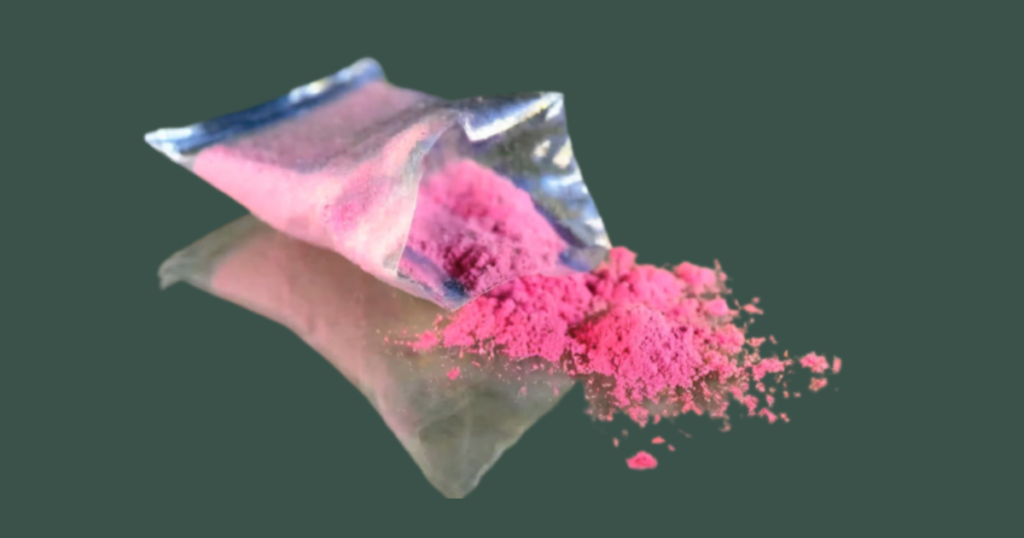With the recent unexpected death of singer Liam Payne being partially attributed to pink cocaine, according to one media outlet, you might have wondered if it’s related to traditional cocaine, and the answer is that it’s not.
The term pink cocaine refers to a synthetic drug called 2C-B, aka tusi, which has been gaining popularity in certain circles, particularly in party scenes. Despite the name, pink cocaine isn’t related to the stimulant effects of regular cocaine, but instead, it blends hallucinogenic properties with a mild stimulant effect. Its growing availability, distribution, and use raise concerning questions about its safety and potential for addiction.
What is Pink Cocaine?
Pink cocaine’s rise in popularity can be traced back to its unique appeal in party scenes and festivals. Known scientifically as 2C-B, the drug’s bright, often pink hue sets it apart from other substances, but its effects are what have truly driven its growing use. Unlike traditional stimulants, pink cocaine blends hallucinogenic properties with a milder stimulant effect, creating an experience that users describe as both mentally intense and physically energizing. The drug’s reputation as a “party enhancer” has contributed to its spread, particularly in areas where synthetic drugs are more accessible. Find local mental health and addiction treatment covered by insurance. Start your journey to recovery today.
The Origins of Pink Cocaine
The term “pink cocaine” didn’t emerge from its chemical composition but rather from its appearance and marketing. Its bright color made it stand out, especially in the club and festival scenes, where visual appeal can sometimes be as influential as the drug’s effects. The name itself led to confusion early on, with many assuming it was just a variation of cocaine. However, as its use spread, it became clear that pink cocaine was something different—offering users a blend of sensory distortion and stimulation that had little in common with the stimulant rush of actual cocaine.
This misunderstanding likely played a role in its initial spread, with people trying it under the assumption it would produce effects similar to cocaine, only to find themselves experiencing something far more hallucinogenic. The misnomer stuck, and it continues to shape how people perceive and seek out the drug.
History and Evolution of Pink Cocaine
The story of pink cocaine, or 2C-B, dates back to the 1970s when chemist Alexander Shulgin first synthesized it. Initially, 2C-B was seen as an experimental psychoactive substance used mainly in controlled settings. But as the years went on, it filtered into underground scenes. By the 1990s, it was already gaining popularity in South America, which is, coincidentally where Liam Payne’s death occurred and where tusi found a strong foothold in nightlife and party culture. European countries soon followed, with regions like Ibiza becoming hotspots for its use in the early 2000s.
What makes pink cocaine unique is not just the drug itself but how its popularity spread geographically. In South America, particularly in Colombia, it became part of the club scene, appealing to users seeking an alternative to traditional stimulants. In contrast, it was adopted more in Europe for festivals and electronic music scenes. Over time, the drug’s presence expanded, and while it’s still less common than more well-known substances, it has maintained a steady presence in certain social circles.
How is Pink Cocaine Made?
The key ingredient of pink cocaine is 2C-B, a synthetic compound derived from the phenethylamine family. This class of chemicals is known for its psychoactive properties, often used in creating substances that affect mood, perception, and cognition. The chemical structure of 2C-B gives it a unique profile, blending hallucinogenic effects with a mild stimulant kick, which is part of its appeal in social settings.
Production methods vary widely, and like many synthetic drugs, purity is always a concern. While pure 2C-B is a distinct chemical, what’s sold on the street can vary drastically. Some batches are made with relatively clean chemical processes, but others are heavily adulterated with substances like amphetamines or even dangerous filler compounds. This inconsistency increases the risk to users, as you never quite know what you’re getting.
Pure 2C-B tends to have a more predictable effect profile, but in reality, most users are getting a mixture of substances. The variability in production methods makes it difficult to anticipate how potent or dangerous any given dose might be, further adding to the risks associated with using pink cocaine.
How is Pink Cocaine Distributed?
Like many synthetic drugs, pink cocaine doesn’t have a uniform method of distribution. It’s most commonly sold in party and club scenes, where the demand for substances that enhance sensory experiences is high. Street dealers often supply it in powdered form or pressed into pills, with the pink hue being a distinctive marker that sets it apart from other substances. But while its appearance might be consistent, what’s inside is far from reliable. The composition and strength can vary dramatically from batch to batch, adding to the uncertainty and risk for users.
The party scene, especially in cities known for their nightlife, is a central hub for pink cocaine distribution. Whether at clubs, festivals, or raves, it’s typically sold in small quantities, appealing to users seeking a combination of stimulation and hallucinogenic effects for a night out. However, its distribution also spans beyond these spaces, finding its way into more underground settings where recreational drug use is more common.
Where is Pink Cocaine Most Prevalent?
Pink cocaine’s popularity has surged in specific regions, most notably in South America and parts of Europe. In countries like Colombia, it’s woven into the nightlife culture, where it is often marketed as a premium product for party-goers looking for an alternative to traditional stimulants. The club scenes in countries such as Brazil and Argentina have also seen spikes in its use, and in these areas, pink cocaine has gained a reputation as a high-end, albeit risky, drug.
In Europe, regions like Ibiza and parts of the U.K. have reported increases in pink cocaine use, particularly among younger adults drawn to its psychedelic effects. While it hasn’t reached the same widespread status as more common drugs like MDMA or cocaine, it’s steadily finding its place in the nightlife of many cities. As trends shift and new synthetic drugs enter the scene, pink cocaine continues to adapt, with distribution shifting to meet the demand in these key regions.
Why is Pink Cocaine Dangerous?
When people hear about pink cocaine, they might assume it’s just another party drug, but its risks go far beyond the usual concerns. One of the biggest dangers with pink cocaine, primarily because it’s sold on the street, is how unpredictable it can be. With no consistency in how it’s made or what it’s mixed with, every dose can be different. What looks like a harmless party drug can quickly turn into something far more dangerous, depending on what’s actually in it. This unpredictability, combined with its hallucinogenic properties, makes pink cocaine a real gamble. Call Today and Reclaim Your Life1-888-546-6005Are You Ready to Get Sober?
Risks of Pink Cocaine Use
One of the most serious risks tied to pink cocaine is contamination. Street drugs are rarely pure, and pink cocaine is no exception. Dealers often cut the substance with cheaper, more dangerous drugs, like amphetamines or other stimulants, to increase profits. This not only makes the effects of the drug wildly unpredictable but also heightens the potential for severe side effects or overdose. Users may think they’re getting a mild hallucinogen, but instead, they could be ingesting a potent cocktail of chemicals.
Another issue is the inconsistency in dosages. With synthetic drugs, there’s rarely any regulation or oversight, which means that one dose might be relatively mild while the next could be far stronger, even if they look the same. This makes it hard for users to know what to expect, increasing the chances of harmful reactions, bad trips, or accidental overdoses.
Potential for Addiction
While pink cocaine is not as physically addictive as traditional cocaine, it does carry a significant risk of psychological dependence. The combination of stimulating and hallucinogenic effects can make the experience feel euphoric and highly desirable, which can lead to repeated use. Users often chase the mental high and sensory enhancement, creating a pattern of use that is difficult to break.
Unlike substances that cause severe physical withdrawal, 2C-B’s addictive qualities lie in the mental and emotional impact. People may not experience the physical cravings typical of hard drugs, but the psychological pull to recreate the experience can be just as strong. Over time, this can lead to regular use and the development of unhealthy patterns, even if the person doesn’t consider themselves “addicted” in the traditional sense.
Mechanism of Action of Pink Cocaine
When people take pink cocaine, or 2C-B, it interacts with the brain in a way that combines both stimulant and hallucinogenic effects. This is part of what makes it so unpredictable. The drug primarily affects serotonin receptors, the same system that substances like LSD or MDMA influence. By altering serotonin levels, 2C-B can drastically change the user’s perception of reality, creating visual and auditory distortions. At the same time, its mild stimulant properties boost energy, which is why it’s often used in social settings like clubs or parties.
Unlike some hallucinogens that leave users feeling physically drained, pink cocaine can provide a balance of mental stimulation and physical energy, which makes it particularly appealing. However, this also makes the drug’s effects more challenging to predict, especially when considering factors like dosage or the presence of other substances in the mix.
Onset, Half-Life, and Duration of Effects
The effects of pink cocaine don’t kick in immediately. Here’s a basic breakdown of how long it takes to feel the drug, how long the effects last, and how quickly it leaves the body:
- Onset: Users begin to feel the first effects 30-60 minutes after ingestion. These include heightened sensory perception and changes in mood or thought patterns.
- Duration: The peak effects typically last around 4-6 hours, with users experiencing mental and physical stimulation during this time. Hallucinogenic visuals may also be present.
- Half-life: 2C-B has a half-life of approximately four hours, meaning it takes this amount of time for half the drug to leave the system. However, lingering effects can continue for several more hours, especially if larger doses are taken.
Understanding these timeframes is crucial, as many users might take additional doses too early, believing the drug isn’t working, which increases the risk of overdose or negative side effects.
Pink Cocaine vs. Cocaine
At first glance, the name “pink cocaine” might make you think it’s just a colorful variation of traditional cocaine. But chemically and functionally, these two drugs are very different. While they both have stimulant properties, their effects on the mind and body diverge significantly, and understanding those differences can highlight why each comes with its own set of risks.
Chemical and Functional Differences
Chemically, 2C-B (pink cocaine) and cocaine are not related. Cocaine is derived from the coca plant and is classified as a stimulant, while 2C-B is a synthetic compound belonging to the phenethylamine family, which includes psychedelics like MDMA and mescaline. Cocaine primarily affects dopamine levels, causing an intense rush of energy and euphoria, while 2C-B works more on serotonin, leading to altered perceptions, mild hallucinations, and sensory enhancement.
In terms of effects, cocaine provides a fast-acting, intense burst of stimulation that makes users feel highly energized and alert. On the other hand, pink cocaine offers a more complex experience, combining both a mild stimulant effect with hallucinogenic properties. While cocaine tends to push users into an “up” state where they feel hyper-focused or driven, 2C-B blends mental stimulation with sensory distortion, leading to a more immersive experience that affects both the mind and body in subtler, yet deeper ways.
Addictive Potential
Both drugs carry the risk of addiction, but the way they hook users is different. Cocaine is known for its strong potential to create physical dependence, largely due to the way it floods the brain with dopamine. The crash that follows its short-lived high can lead users to seek out more of the drug just to feel normal again, which is one reason it’s so highly addictive.
With pink cocaine, the addiction is more psychological than physical. Users are drawn to the mental effects—the heightened senses, the altered perceptions, the combination of energy and psychedelia. While it’s less likely to cause physical withdrawal symptoms, the desire to recreate that unique experience can lead to chronic use, especially in social settings where it’s readily available.
In terms of long-term health risks, both drugs pose significant dangers. Cocaine’s impact on the cardiovascular system is well-known, increasing the risk of heart attacks, strokes, and long-term damage to the nasal passages when snorted. Pink cocaine’s risks, while different, are tied to its unpredictable effects and the potential for psychological harm, particularly when used in high doses or in combination with other substances. Both drugs can lead to a cycle of misuse that’s difficult to break, each in its own way.
Is Pink Cocaine Legal?
While pink cocaine may be prevalent in some social scenes, its legal status is far from straightforward. Like many synthetic drugs, its regulation can vary widely depending on the country. Some places have strict laws against its use, while others have looser enforcement, allowing it to circulate more freely. Understanding how different regions handle pink cocaine legally is essential, especially for users who may not realize the severity of the consequences.
Regulations by Country
In the United States, 2C-B, the chemical behind pink cocaine, is classified as a Schedule I substance, meaning it is considered to have no accepted medical use and carries a high potential for abuse. This puts it in the same category as drugs like heroin and LSD, making its possession, distribution, or manufacture illegal under federal law.
Across Europe, the legal status of pink cocaine varies. In some countries like Germany, it is also classified as a controlled substance, and its use or sale can lead to severe penalties. Other European nations may not have 2C-B explicitly listed in their drug schedules, but enforcement often follows a similar pattern—making its sale and distribution illegal. In places like the U.K., 2C-B falls under the Psychoactive Substances Act, criminalizing its production and supply.
In South America, particularly in countries like Colombia, where pink cocaine has gained popularity in nightlife circles, the drug exists in a legal gray area. While technically illegal, enforcement is inconsistent. This allows for widespread use in certain regions, where it’s sold openly in clubs and at festivals, even though the risk of legal action remains.
Consequences of Possession or Distribution
The consequences of being caught with pink cocaine can be significant, depending on the country and the quantity involved. In the U.S., possessing even small amounts can lead to criminal charges, including heavy fines and prison sentences, particularly for distribution or trafficking. The severity of these penalties increases with the amount of the drug found and whether there is an intent to distribute.
In Europe, penalties vary. For example, in Germany, possessing or distributing 2C-B could lead to years in prison and steep fines. In countries with stricter enforcement, such as Sweden, any involvement with synthetic drugs like 2C-B is treated harshly, with law enforcement actively targeting users and dealers alike.
In regions where enforcement is more lenient, such as parts of South America, possession might not result in significant legal consequences, but trafficking or large-scale distribution can still bring about severe punitive consequences. Even in countries with looser regulations, international trafficking of pink cocaine can result in hefty charges, particularly if it crosses borders into regions with stricter drug laws.
The legal risks associated with pink cocaine should not be underestimated, especially since many users aren’t fully aware of how their country handles synthetic drugs. A single arrest for possession or distribution could lead to life-altering consequences, regardless of the substance’s popularity in certain scenes.
Emotional and Perceptual Effects of Pink Cocaine
A study evaluating the effects of Pink cocaine on emotional, subjective, and cardiovascular responses revealed several key findings. Participants reported heightened emotional experiences, including a reduction in anger and increased sensitivity to negative emotional stimuli. Interestingly, 2C-B users found it harder to recognize expressions of happiness, which may impact social interactions while under its influence.
Perceptually, users experienced mild hallucinogenic states, including changes in visual and auditory perception, along with a sense of euphoria and well-being. These effects suggest that 2C-B functions as an empathogen, enhancing emotional connectedness while inducing slight psychedelic experiences. Furthermore, while 2C-B shares some similarities with MDMA, it demonstrates a distinctive pattern of emotional reactivity that could be of interest for further exploration, particularly regarding its potential therapeutic applications.
Though 2C-B’s effects are generally reported as positive, its influence on emotions and perception may also contribute to increased sensitivity to negative stimuli, requiring caution for individuals susceptible to emotional distress.
The Dangers of Pink Cocaine and Addiction
Pink cocaine might seem appealing because of its hallucinogenic effects and its reputation as a party drug, but the risks far outweigh the short-term highs. Its unpredictable composition and the potential for dangerous side effects make it especially risky for anyone who uses it. The fact that its contents can vary from one batch to the next only heightens the danger, with users never truly knowing what they are ingesting. Beyond the immediate physical risks, pink cocaine’s potential for psychological dependence can trap users in a cycle of seeking the next high, making it difficult to break free.
If you or someone you know is struggling with pink cocaine or any other substance, it’s essential to seek professional help. Addiction can be an isolating experience, but support is available, and recovery is possible. Whether through therapy, rehab, or support groups, taking that first step can lead to a path of healing where both mental and physical health can be restored.
References:
Drug Enforcement Administration (DEA). Pink Cocaine. Retrieved from https://www.dea.gov/pink-cocaine
The New York Times. (2024, October 21). What is Pink Cocaine? Retrieved from https://www.nytimes.com/2024/10/21/well/what-is-pink-cocaine.html
Kusnacht Practice. Understanding the Effects of 2C-B Drug Use. Retrieved from https://kusnachtpractice.com/articles/understanding-the-effects-of-2c-b-drug-use/
PubMed Central (PMC). (2015). Article ID PMC4620274. Retrieved from https://pmc.ncbi.nlm.nih.gov/articles/PMC4620274/
NYU Institute for Public Knowledge. (2024). Pink Cocaine: The Party Drug Cocktail Putting a Growing Number of Lives at Risk. Retrieved from https://ifp.nyu.edu/2024/news/pink-cocaine-the-party-drug-cocktail-putting-a-growing-number-of-lives-at-risk/
CBS News New York. Pink Cocaine and the Fentanyl Threat. Retrieved from https://www.cbsnews.com/newyork/news/pink-cocaine-tusi-fentanyl/
NBC News. (2024). Pink Cocaine and Liam Payne: What to Know. Retrieved from https://www.nbcnews.com/health/health-news/pink-cocaine-liam-payne-death-what-know-rcna176556
CBC News. Pink Cocaine Explainer. Retrieved from https://www.cbc.ca/news/pink-cocaine-explainer-1.7360262







